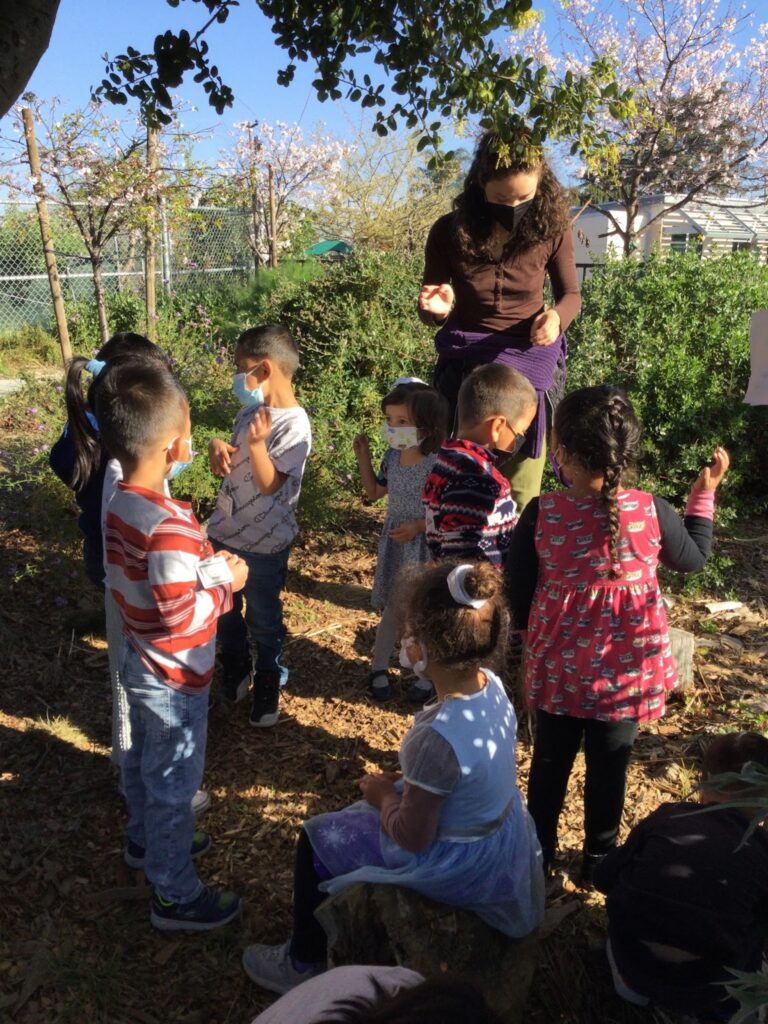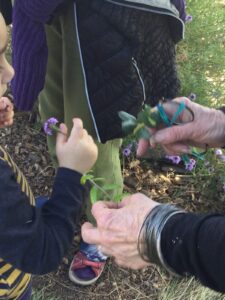Composting and the Life Cycle of Plants, Educare
Today in the garden, Allegra introduced the children to composting. But today was so much more than that! Today was the day that we observed the totality of the children’s experiences in the garden coming together to introduce them to the cycle of life of the plants in the garden.
The children are familiar with the oak tree in their garden, they remember hugging it in gratitude for its shade, and they remember collecting the acorns over their many visits. Many also remember the previous lesson when they planted acorns (and took responsibility for watering them).
 Today, with the introduction of composting, the layering of green and brown materials and the adding of water, the children began to understand what happens to the plants when they die. They become compost for seeds to take root in. The children had the opportunity to feel rich composted soil, and to understand that by layering the green and brown material they were helping to create compost for seeds to sprout in. They added their “compost cake” to the compost bin and took turns spinning it to hasten the process.
Today, with the introduction of composting, the layering of green and brown materials and the adding of water, the children began to understand what happens to the plants when they die. They become compost for seeds to take root in. The children had the opportunity to feel rich composted soil, and to understand that by layering the green and brown material they were helping to create compost for seeds to sprout in. They added their “compost cake” to the compost bin and took turns spinning it to hasten the process.
And, we returned to the oak tree and noticed the flowers on the branches, and several baby oak trees growing under the tree where the acorns had fallen into the compost below months ago. We also explored some mushrooms growing on a stump under the tree. One child expressed a love and interest in seeing and examining the mushroom.
Allegra shared a saying that she used to remember this cycle of life:
“The dirt made my lunch,
And my lunch made the dirt”
We encouraged the teachers to help the children add food scraps to the compost bin during the week, and to continue spinning the bin.
There were many learning moments today. Some were when teachers shared facts about the plants. For example, we learned that peas and lupines are nitrogen-fixing plants. We looked closely at the nodules on the roots of these plants. And we ate the snap peas and learned that they (and the fava beans in our garden) add nitrogen to the soil, and that the peas are healthy for us!
And other learning moments were when children interacted with the plants in the garden, for example touching them, breaking the brown plants down into smaller pieces, smelling the flowers, feeling the fuzz on the inside of the fava bean pod. All of these hands-on experiences in the presence of supportive adults help the children connect with nature in a sensory way.
One child gathered red and green swiss chard into a bouquet. She announced it was “for my mama…to cook” She noticed the “red” and the “green” and traced the red veining with her finger. On her way back to class, she offered a leaf to a friend…”for you!” This tiny story, captured by her teacher, reflects her respect for the edible food, her love of the garden, her caring for her friend, and her desire to share this experience with her Mom!
There were too many interactions and learning moments to share here, but below we share a few photos of them, and it is obvious from the focused eyes, engaged hands, movements and placements of bodies, that the children were engaged and in the learning moment. These are the moments they will continue to build on with each garden experience that follows.
Pretending to be decomposers: flies, worms, mushrooms, roly polies:
Exploring the green and brown materials for composting, and exploring the snap pea pod. Wondering what is in here? How does it feel inside? How many peas are in it? How does the pea taste?
Making the “compost cake” with layers of brown and green:
Exploring sorghum and lupine plants, becoming familiar with different textures, smells, shapes:
Working together, collaborating, spinning the compost bin:
Swiss chard for Mom…(story above):
Showing the children the different greens of the baby oak leaf (left hand) and the year old oak leaf (right hand):












